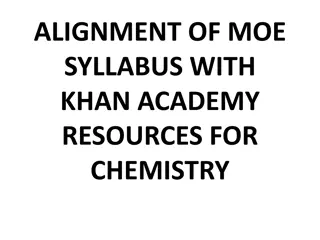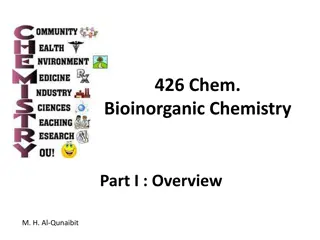Chemistry Study Materials and Practice Questions
This collection of chemistry study materials includes information on reactions, solubility, electrolytes, and solution stoichiometry. Practice questions cover classifying solutes, predicting solubility of salts, writing ions produced in water, and determining precipitates in reactions. Includes a molarity calculation example as well.
Download Presentation

Please find below an Image/Link to download the presentation.
The content on the website is provided AS IS for your information and personal use only. It may not be sold, licensed, or shared on other websites without obtaining consent from the author.If you encounter any issues during the download, it is possible that the publisher has removed the file from their server.
You are allowed to download the files provided on this website for personal or commercial use, subject to the condition that they are used lawfully. All files are the property of their respective owners.
The content on the website is provided AS IS for your information and personal use only. It may not be sold, licensed, or shared on other websites without obtaining consent from the author.
E N D
Presentation Transcript
WARM-UP Nitrogen and hydrogen gas react to form ammonia according to the reaction N2 (g) + 3H2 (g) > 2NH3 (g) If a flask contains the mixture of reactants represented to the right, which image below best represents the mixture in the flask after the reactants have reacted completely? What is the limiting reactant? Which reactant is in excess?
QUIZ FRIDAY Sections 4.1-4.2, 4.5-4.6 Labs are fair game Might be some ch 1-3 stuff too! Molarity, solubility, electrolytes, net ionic reactions, solution stoichiometry The only solubility rules you MUST memorize are that potassium, sodium, ammonium, and nitrate compounds are ALWAYS soluble
CHAPTER 4 STUDY QUESTIONS Answer on whiteboards Work together PPT will be online
CLASSIFY EACH OF THE FOLLOWING SOLUTES AS AN ELECTROLYTE OR NONELECTROLYTE sugar sodium hydroxide common salt (NaCl) hydrochloric acid alcohol copper sulfate acetic acid carbonic acid
PREDICT THE SOLUBILITY (WILL THEY DISSOLVE IN WATER OR NOT) OF THE FOLLOWING SALTS: sodium sulfate potassium chromate silver bromide nickel (II) hydroxide aluminum nitrate barium sulfide ammonium acetate strontium iodide
WRITE THE IONS THAT ARE PRODUCED WHEN THE FOLLOWING SUBSTANCES DISSOLVE IN WATER. Example: NaCl = Na+ and Cl- Mg(OH)2 K2SO4 NaHCO3 (NH4) 3PO4 NaClO
PREDICT WHETHER OR NOT THE FOLLOWING REACTIONS WILL LEAD TO A PRECIPITATE. WRITE DETAILED AND NET IONIC EQUATIONS FOR ALL THE REACTIONS. a. potassium chromate and lead acetate silver perchlorate and ammonium chloride potassium carbonate and copper acetate sodium fluoride and magnesium iodide barium nitrate and potassium sulfate b. c. d. e.
If 5.00 grams of sodium hydroxide is dissolved to make 600 mL of solution, what is its molarity?
How many grams of potassium chloride has to be dissolved in water to produce 2.0 liters of a 2.45 M solution?
If 24.63 grams of magnesium chloride is dissolved to make exactly 3 liters of solution calculate the concentrations of the ions in the solution (in moles/liter).
What is the molarity of the solution that results from adding 25 mL of a 0.15 M solution of sodium hydroxide to sufficient water to make 500 mL of solution?
What volume of a 2.50 M solution of hydrochloric acid is required to prepare 2.0 liters of a 0.30 M solution?
When excess silver nitrate was added to a 25.0 mL sample of a solution of calcium chloride, 0.9256 gram of silver chloride precipitated. What is the concentration of the calcium chloride solution?
Determining the formula of Copper Oxide Lab Read through the lab information Complete the prelab in your lab notebook before class tomorrow Safety hair tied back, no loose clothing























